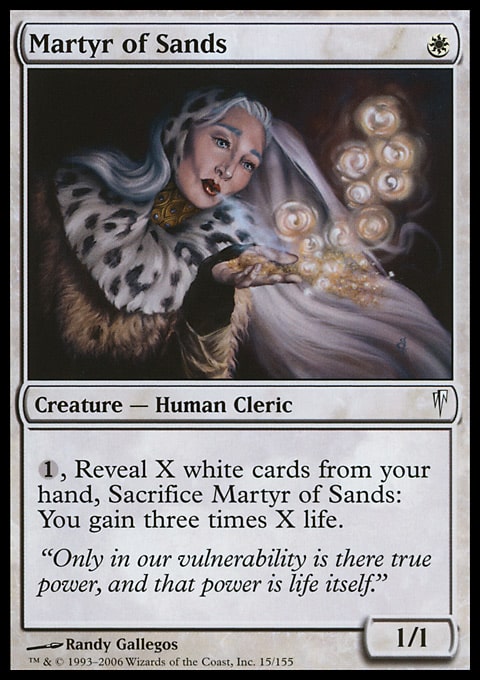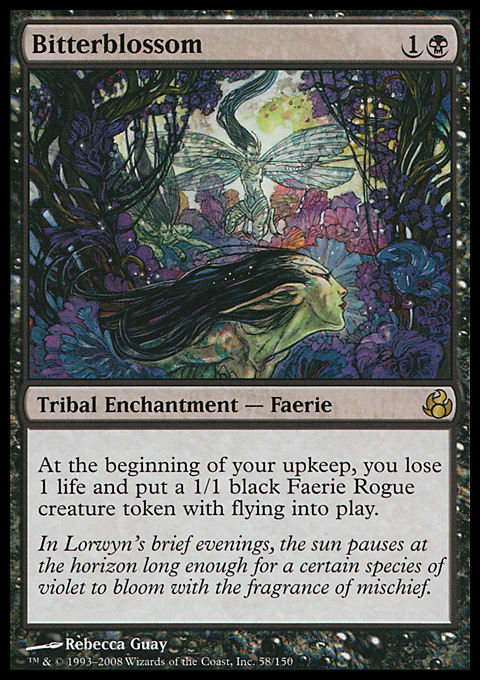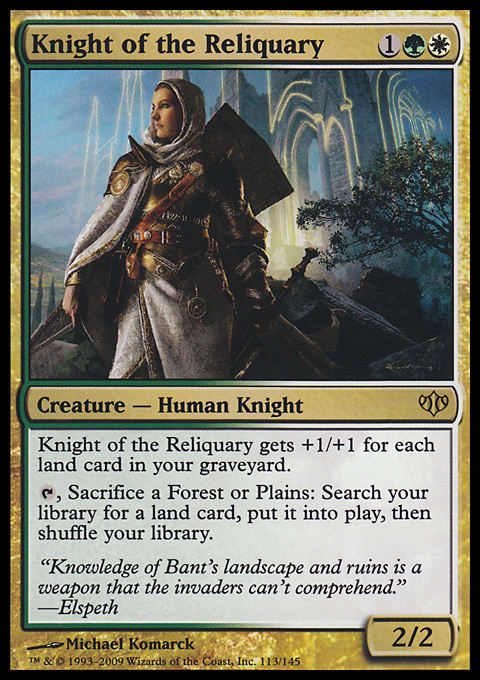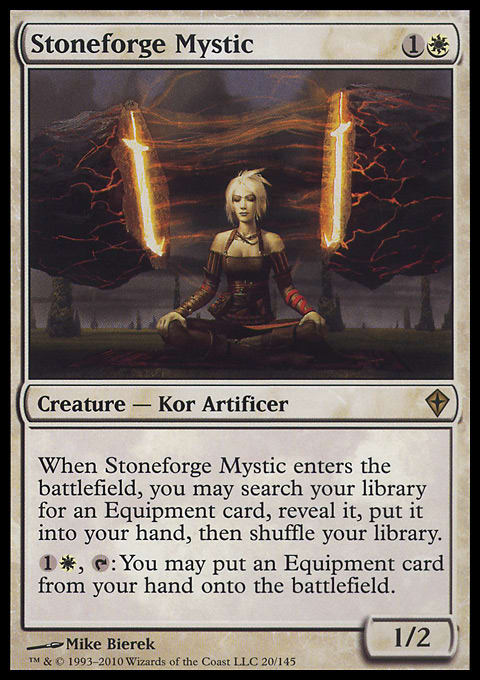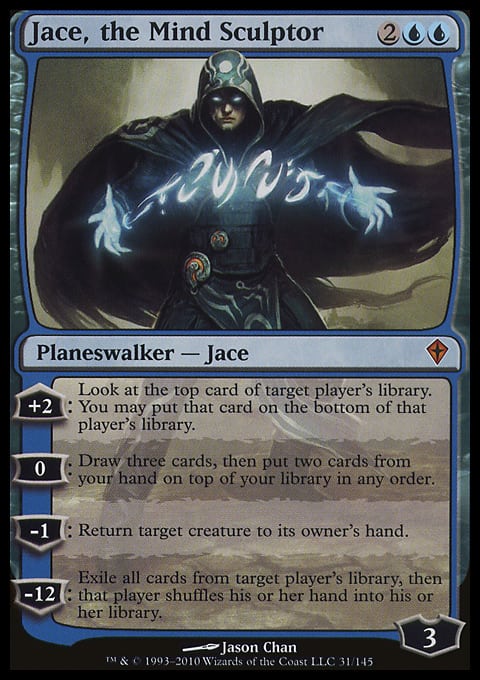Welcome! This week, I thought I’d give everyone a holiday treat, and dissect some of my favorite decks from my Magic career. (Well, the fact that the formats are sort of in a holding pattern, waiting for the new year and the new set release also contributed.) I’ve wanted to do this for a while, actually. I have some decks that I remember fondly as pet projects that I so desperately wanted to make great, and some that were very clearly unbeatable boogeymen of their respective formats. All of these decks come with a healthy dose of nostalgia for me, so without further ado, let’s discuss some of the best, most fun, or most formative decks for me as a young player!
Honorable Mention: Martyr Control
This was the first “good” deck that I ever tuned. Sure, I’d played Krark-Clan Ironworks combo in Mirrodin Standard, and I’d worked on a crappy Boros deck when Ravnica first came out, but Martyr of Sands Control was my first love as a deck designer. My friend Conor Moran (also the first good Magic player I ever befriended) and I worked on Martyr of Sands shells to beat up on a metagame rife with various level-one aggro decks and level-two Lightning Helix-based midrange decks. Gruul and Rakdos aggro competed with Jeskai or Bant Momentary Blink strategies (although back then there was no official word to describe these tri-color decks), but we had an edge. Oh, did we ever. Then Gabriel Nassif had to blow up our spot by playing Martyr-Tron at Worlds 2006 and expose our tech to the world! No matter, we figured that a bunch of middle and high schoolers would be easy pickings for a deck that was so heavily slanted to beat the obvious archetypes.
Now, you all know that I love my readers. In fact, I love them so much that I spent an hour digging around old forums to find my (nearly unreadable) tournament report and decklist from July 2007, where I was pleased to announce that I went 7-3-3 in the Magic Scholarship Series Nationals for a cool $500. I’m not really sure how I determined that my numbers were correct, but for a soon-to-be ninth grader, this finish guaranteed that I walked into my first day of high school with an undeserved swagger.
Here’s the list:
Martyr Control ? Standard 2007| Ben Friedman, Magic Scholarship Series Nationals
- Creatures (11)
- 3 Aeon Chronicler
- 4 Court Hussar
- 4 Martyr of Sands
- Instants (4)
- 4 Condemn
- Sorceries (13)
- 2 Sunscour
- 3 Proclamation of Rebirth
- 4 Compulsive Research
- 4 Wrath of God
- Enchantments (5)
- 2 Sacred Mesa
- 3 Story Circle
- Artifacts (4)
- 4 Azorius Signet
- Lands (23)
- 1 Snow-Covered Island
- 5 Snow-Covered Plains
- 2 Adarkar Wastes
- 2 Mouth of Ronom
- 2 Urza's Factory
- 3 Ghost Quarter
- 4 Flagstones of Trokair
- 4 Hallowed Fountain
- Sideboard (15)
- 4 Disenchant
- 4 Tormod's Crypt
- 2 Faith’s Fetters
- 1 Sacred Mesa
- 1 Proclamation of Rebirth
- 3 Pull from Eternity
What a beauty! I fondly remember locking out various Kird Ape strategies with the power of Martyr-Proclamation, and as my tournament report can attest, that weekend saw my DCI rating skyrocket above 1800. I lost in the finals of two Last Chance Qualifiers for the real US Nationals, and min-cashed the junior event.
I don’t have too much to say about the deck and how poorly I built it, because much of that format is lost to time. I will say, though, that I distinctly remember trying to splash both Black and Red in this deck off of Prismatic Lens. What can I say? I wanted to play sweet cards like Detritivore and Extirpate! Thankfully, I learned some things about deck-building discipline by the time Morningtide rolled around, and my next favorite deck was the annoyingly powerful . . .
10. Faeries
I’ll admit defeat here; I know of no record of any Faeries decklist that I ever played. I remember playing a pair of Loxodon Warhammers (the best Batterskull before there was Batterskull) in order to better combat Elves, Kithkin, and Red-based aggro decks. I even remember slamming a 7/4 Lifelink Mistbind Clique into my opponent’s Broodmate Dragon + token and using my Peppersmoke to trade with both 4/4 Dragons. It was a wonderful time for an enterprising young player to learn all about the intricacies of timing, how to best trap the opponent between the mid-combat Mistbind Clique and the Time Walk/Counterspell mode of Cryptic Command.
In lieu of my list, Sam Black’s deck from Pro Tour Kyoto 2009 was an excellent representation of the archetype toward the end of its lifecycle:
Faeries ? Standard 2009 | Sam Black, Pro Tour Kyoto 2009
- Creatures (12)
- 1 Vendilion Clique
- 3 Scion of Oona
- 4 Mistbind Clique
- 4 Spellstutter Sprite
- Planeswalkers (2)
- 2 Jace Beleren
- Instants (15)
- 2 Terror
- 3 Agony Warp
- 3 Broken Ambitions
- 3 Peppersmoke
- 4 Cryptic Command
- Sorceries (2)
- 2 Thoughtseize
- Enchantments (4)
- 4 Bitterblossom
- Lands (25)
- 4 Swamp
- 5 Island
- 2 Faerie Conclave
- 2 Underground River
- 4 Mutavault
- 4 Secluded Glen
- 4 Sunken Ruins
- Sideboard (15)
- 1 Peppersmoke
- 1 Jace Beleren
- 2 Thoughtseize
- 2 Sower of Temptation
- 2 Countersquall
- 2 Flashfreeze
- 2 Glen Elendra Archmage
- 3 Infest
The best primer on the now-obsolete archetype (the old Extended version, of course) comes from none other than the great Paulo Vitor Damo Da Rosa, from six years ago. Take a trip back and enjoy!
Now, Faeries was the first deck I played back when I thought I was the next big thing at my local store. There were several of us young guns, back at the now-defunct Legends game store in Baltimore, and we grew up together while competing for those $100 or more prize pools week-in and week-out. Those Sunday cash tournaments were the undisputed highlight of my weeks back in middle and high school (since I certainly wasn’t being invited out to parties!) Legends is where I cut my teeth, and Faeries, Jund, and B/W Tokens were the decks that took me from a scrub to a contender. Speaking of which . . .
9. B/W Tokens
B/W Tokens ? Old Standard | Ben Friedman
- Creatures (14)
- 3 Cloudgoat Ranger
- 3 Murderous Redcap
- 4 Kitchen Finks
- 4 Tidehollow Sculler
- Planeswalkers (3)
- 3 Ajani Goldmane
- Instants (6)
- 3 Path to Exile
- 3 Zealous Persecution
- Sorceries (4)
- 4 Spectral Procession
- Enchantments (8)
- 4 Glorious Anthem
- 4 Bitterblossom
- Lands (25)
- 1 Swamp
- 3 Plains
- 2 Mutavault
- 3 Reflecting Pool
- 4 Arcane Sanctum
- 4 Caves of Koilos
- 4 Fetid Heath
- 4 Windbrisk Heights
- Sideboard (15)
- 4 Burrenton Forge-Tender
- 1 Zealous Persecution
- 3 Identity Crisis
- 3 Thoughtseize
- 4 Wrath of God
Another beautiful archetype, with power, synergy, disruption, and an excellent sideboard. This was the list from my first PTQ Top 8, where I lost to the unflappable Tommy Ashton in a bloodbath of a finals. If Faeries marked the start of my journey from a small-child scrub to a competent player, B/W Tokens marked the start of my serious run at high-level competitive play. Sure, the deck was a little bit clunky, but aside from Kithkin, the whole format was fairly clunky. And with a playset of Wraths in the sideboard, I was more than prepared. Even without many 1-drop spells, a curve of Bitterblossom-Spectral Procession-Ajani Goldmane would still beat most opponents, and I managed to do just that for most of the format. But it was not to be, and my Pro Tour dreams would have to be deferred for a season or two. You’d think it would have taught me humility, but it only increased my fire and my confidence that I was ready to play in the big leagues. It took a couple of PTs for me to learn that that was not the case.
Incidentally, I also distinctly remember listening to “40 Oz. To Freedom” by Sublime on repeat to calm my nerves between rounds at this PTQ. You remember the oddest things, I swear.
Anyways, after an incredibly lucky tournament that saw me make it to the PT, and an equally disappointing failure in San Juan itself, I got back onto my grind with one of my favorite archetypes of all time. Despite myself, I was able to push back and qualify for my most memorable PT ever (in Amsterdam, no less!) with . . .
8. Mythic Conscription
DECK ? FORMAT | Ben Friedman
- Creatures (26)
- 3 Birds of Paradise
- 3 Dauntless Escort
- 4 Knight of the Reliquary
- 4 Lotus Cobra
- 4 Noble Hierarch
- 4 Rhox War Monk
- 4 Sovereigns of Lost Alara
- Planeswalkers (7)
- 3 Elspeth, Knight-Errant
- 4 Jace, the Mind Sculptor
- Enchantments (2)
- 2 Eldrazi Conscription
- Lands (25)
- 2 Island
- 2 Plains
- 4 Forest
- 1 Stirring Wildwood
- 2 Sejiri Steppe
- 2 Sunpetal Grove
- 4 Celestial Colonnade
- 4 Misty Rainforest
- 4 Verdant Catacombs
- Sideboard (15)
- 3 Baneslayer Angel
- 1 Dauntless Escort
- 2 Sphinx of Jwar Isle
- 3 Bant Charm
- 2 Deprive
- 2 Negate
- 2 Path to Exile
Yup, this was a Standard deck. Several of the cards here are what we would nowadays call “overpowered”. Knight of the Reliquary, Noble Hierarch, freaking Jace!? This was Standard-legal? Well, you didn’t have to be a genius to figure out that this was the archetype with the highest raw power level, and I took down a Roanoke PTQ the week after returning from San Juan. It had great sideboard cards to shift to a less all-in Kibler-style deck, by becoming significantly more aggro-control. Seven counterspells and another Dauntless Escort allowed a seamless transition to a threat-and-counterspell-dense nightmare for control, and Path to Exile and Baneslayer Angel offered a way to better respond to aggressive decks. Sphinx of Jwar Isle also covered Jund nicely, as a hard-to-answer top end threat that also brick-walled their offense.
But really, this deck was mostly about attacking on turn three with a fourteen-power Lotus Cobra. Noble Hierarch, Lotus Cobra, fetchland, crack, get up to 6 mana, cast Sovereigns, attack. Great game!
I remember piloting variants on this archetype all summer long, trade-grinding and battling local Standard tournaments at least three times a week. Ah, to be seventeen, with Dad’s car keys in my pocket and the best archetype in the format in my backpack! I’d love to make this particular style of deck work again, if only for reasons of nostalgia, but Bant Eldrazi in Modern is a pretty great stand-in. Incidentally, after bricking the PT in Amsterdam, I was hungry to attack the next couple of PTQ seasons. I couldn’t buy a win in Limited at the time (hence the teasing nickname, 40-card Friedman), so Paris passed me by. Nagoya’s PTQ season was four-year Extended, and I still had visions of crushing with my favorite cards from Shards of Alara block, so I did the obvious thing and started brewing . . .
7. Mythic-Blade
Mythic-Blade ? Old Standard | Ben Friedman
- Creatures (23)
- 3 Stoneforge Mystic
- 4 Birds of Paradise
- 4 Knight of the Reliquary
- 4 Lotus Cobra
- 4 Noble Hierarch
- 4 Sovereigns of Lost Alara
- Planeswalkers (4)
- 4 Jace, the Mind Sculptor
- Instants (4)
- 4 Mana Leak
- Enchantments (2)
- 2 Eldrazi Conscription
- Artifacts (2)
- 2 Sword of Feast and Famine
- Lands (25)
- 1 Plains
- 2 Island
- 4 Forest
- 1 Murmuring Bosk
- 1 Sejiri Steppe
- 1 Tectonic Edge
- 2 Flooded Grove
- 2 Razorverge Thicket
- 3 Celestial Colonnade
- 4 Misty Rainforest
- 4 Verdant Catacombs
- Sideboard (15)
- 3 Burrenton Forge-Tender
- 3 Kitchen Finks
- 4 Mirran Crusader
- 3 Bant Charm
- 2 Path to Exile
This was the first time that I seriously thought I’d broken the format. I still maintain to this day that this was the best deck in four-year Extended. When Stoneforge Mystic-Sword of Feast and Famine is your backup plan, things are pretty extravagant. Mirran Crusader was for Faeries, Kitchen Finks and Forge-Tender were for Red aggro, and the counterspells were for the Valakut and control decks of the format. The deck was lean, mean, and Stoneforge-Sword fixed all of the problems inherent to a deck full of mana dorks. Keep in mind, this was before New Phyrexia came out, so we still didn’t have Batterskull. I remember Ricky Sidher and Michael Hetrick winning MTGO PTQs with the first Extended cuts of Stoneblade, but Spellstutter Sprite couldn’t hold a candle to Sovereigns of Lost Alara. Bant Charm incidentally handled opposing equipment very, very well, so I was thrilled to be paired against the Stoneforge semi-mirrors. There wasn’t a matchup I feared in the whole damn format, and it was only due to my poor play that I didn’t qualify for the PT that season. Four PTQ top 8’s, four exits in either the quarter- or semi-finals. This was my first “what if?” season, and it pushed me to the brink of quitting the game entirely.
Well, it would have, except that my DCI rating was sky-high at this point, and the nascent SCG Open Series came to Baltimore just in time for one of the best decks I’ve ever played to dominate the tournament. I needed to win a few rounds in order to push my rating to 2080, which was my predicted cut-off for the Pro Tour qualification.
My Standard weapon of choice? Well, let’s just say that if it were legal in Modern right now, it would be by far the best deck in that format. Without further ado . . .
6. Twin-Blade
Twin-Blade ? Old Standard | Ben Friedman
- Creatures (10)
- 2 Spellskite
- 4 Deceiver Exarch
- 4 Stoneforge Mystic
- Planeswalkers (4)
- 4 Jace, the Mind Sculptor
- Instants (7)
- 2 Dismember
- 2 Spell Pierce
- 3 Mana Leak
- Sorceries (7)
- 3 Gitaxian Probe
- 4 Preordain
- Enchantments (3)
- 3 Splinter Twin
- Artifacts (3)
- 1 Sword of Feast and Famine
- 2 Batterskull
- Lands (26)
- 2 Plains
- 3 Island
- 3 Mountain
- 1 Celestial Colonnade
- 1 Terramorphic Expanse
- 4 Arid Mesa
- 4 Glacial Fortress
- 4 Scalding Tarn
- 4 Seachrome Coast
- Sideboard (15)
- 1 Sword of War and Peace
- 2 Emeria Angel
- 2 Combust
- 2 Dispel
- 2 Divine Offering
- 2 Mental Misstep
- 4 Pyroclasm
Let’s count the cards on the Modern Banned List, shall we?
Jace, the Mind Sculptor. Splinter Twin. Stoneforge Mystic. Preordain. Mental Misstep.
And this was a Standard-legal deck.
I have no words.
I went 8-2 in this Standard Open, which meant that my rating stood pretty much the same as it was going in. I needed to 9-1, damn it! The next day, I unintentionally drew with Edgar Flores en route to a heartbreaking 9th place finish in the Legacy Open. He was also in the hunt for the elusive 2080 rating, so he refused to concede to me when we went to time. He ended up jumping me in tiebreakers to squeak into 8th place. I was fairly crushed, especially when I learned that the Open had been downgraded from a 5x ELO to a 3x ELO multiplier. Not only that, but the reporting for the tournament was delayed a week, so I wouldn’t have time to know if I needed to battle in a last-minute tournament or if it was foolish to take that kind of chance! (As you can see, the problems with ELO ratings-based invites were numerous at the time.) With nothing better to do, I was forced to wait, passing the few weeks with my non-Magic friends and trying to enjoy the summer between senior year of high school and freshman year of college.
Fast forward to the Wednesday of the DCI ratings update. I had just gotten home from a friend’s house, and I was furiously updating the page to see if I’d made the requisite leap in ratings points. Well, I’ll put it like this. Never let it be said that ol’ 40-Card isn’t lucky, because Edgar’s loss in the quarterfinals of that Open dropped him under me, and my “disappointing” miss on tiebreakers turned out to be the best 9th place finish I ever had!
That fall, I got lucky again with a Top 50 finish in Pro Tour: Philadelphia, qualifying me for Worlds in San Francisco and Pro Tour: Honolulu. Honestly, if it weren’t for that 9th place finish, I might have never propelled myself onto the Pro Tour. Life is weird like that sometimes.
I’ll be back next week with the latter half of my most memorable decks, but until then, try to keep the power of those seemingly innocuous moments in mind. You never know when a single event (even an ostensibly disappointing one) will change the course of your life, so embrace the variance and try to stay open to as many opportunities as you can.
Happy New Year!













